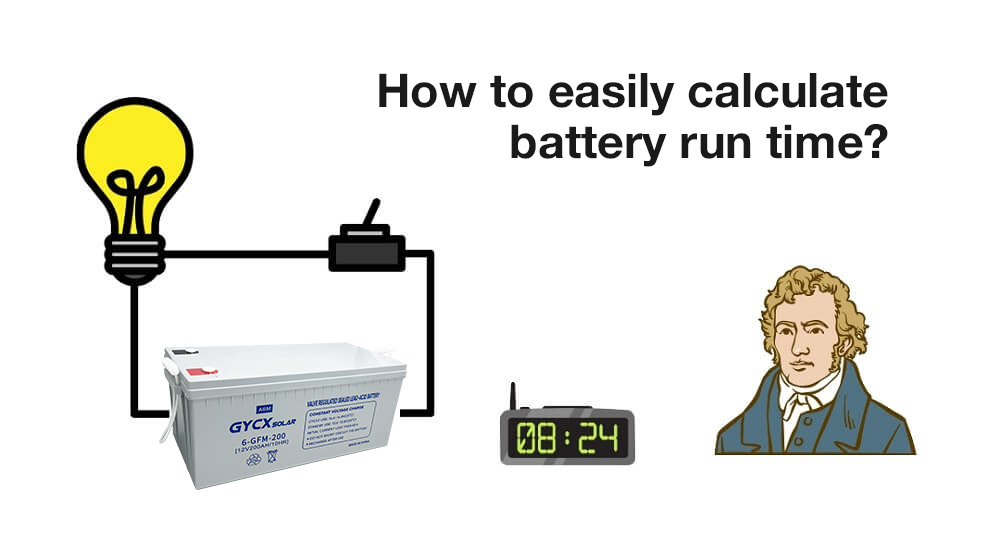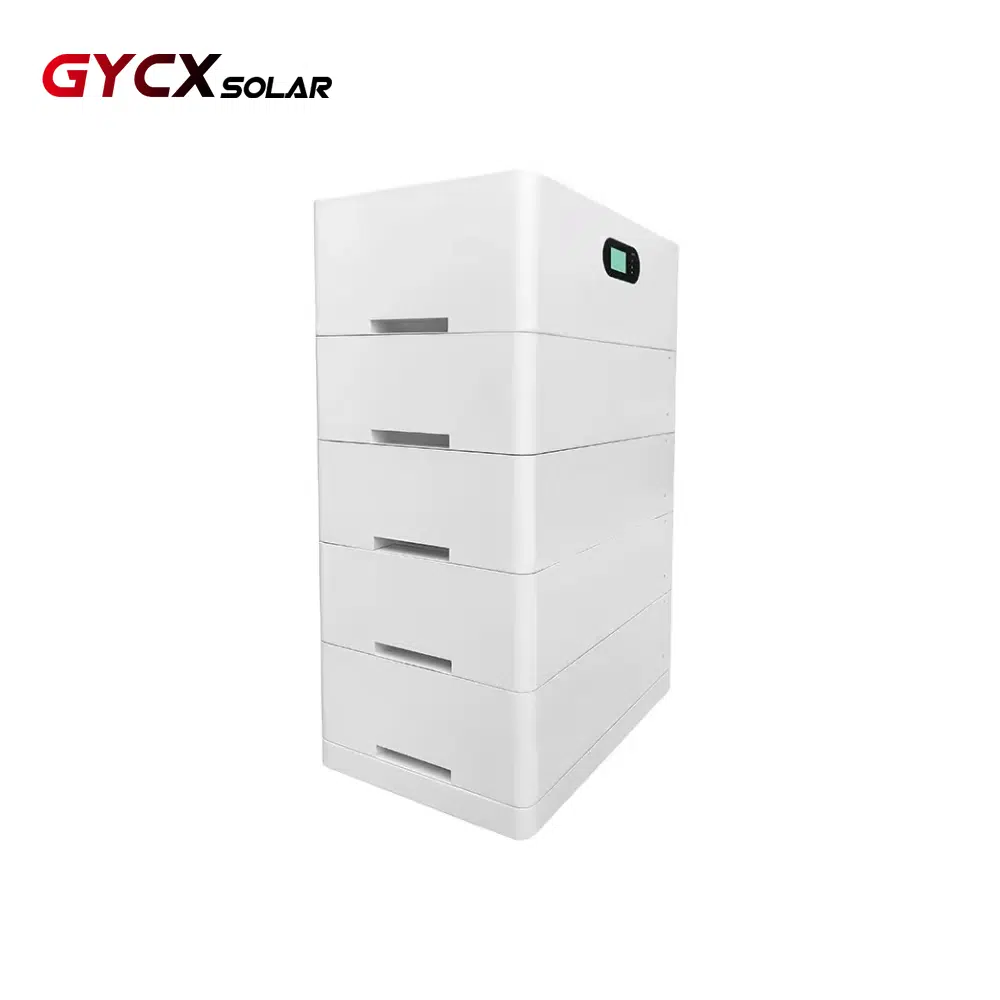This guide will provide you with a detailed explanation of how to calculate how long a battery will last.
Analyze the key factors that affect its running time and provide a practical battery running time formula calculator.
Help you accurately evaluate the battery life of your device.
Part 1: Definition of Battery Operating Time

The battery runtime calculation refers to the duration during which the battery can continue to supply power to the device after a single charge or replacement.
It reflects the duration of use of the device after a single charge is completed.
For example, if the battery life of a smartphone is 10 hours, then under normal usage conditions, the device can run continuously for 10 hours before needing to be recharged.
Understanding battery operating time can help users better manage device usage, especially in situations where power is limited or unable to charge in a timely manner, which is particularly important.
Part 2: How to easily calculate battery run time?

To calculate battery run time, a simple formula can be used, which is based on battery capacity and device power consumption.
The following is the calculation method:
Battery running time (hours)=battery capacity (mAh or Wh)/device power consumption (mA or W)
For example, if you have a battery with a capacity of 5000mAh and the device’s power consumption is 100mA, the running time can be calculated as follows:
Running time=5000mAh/100mA=50 hours
Calculation steps description:
Determine battery capacity
Firstly, find the capacity of the battery, usually expressed in milliampere hours (mAh) or watt hours (Wh).
This information can usually be found in the specifications of the battery itself or the device.
Determine device power consumption
Next, determine the power consumption of the device, usually measured in milliamps (mA) or watts (W).
You can obtain this data by consulting the user manual or technical specifications of the device.
Apply formula calculation
After obtaining the battery capacity and device power consumption, you can calculate the battery’s running time using the above formula.
Part 3: Understanding the formula for battery running time

To understand the formula for battery operating time, it is necessary to master the relationship between amps, watts, and volts.
Here are brief introductions of these units:
Ampere (A):
Ampere is a unit for measuring the intensity of current in a circuit, representing the amount of charge passing through a certain point in the circuit per unit of time.
The formula is:

Among them:
I is the current, measured in amperes (A);
Q is the amount of charge, measured in coulombs (C);
T is time, measured in seconds (s).
Volt (V):
Volt is a unit for measuring the potential difference between two points in a circuit, representing the force or pressure of the driving current.
The formula is:

Among them:
V is voltage, measured in volts (V);
W is the amount of work completed, measured in joules (J);
Q is the amount of charge, measured in coulombs (C).
Watt (W):
Watt is a unit that measures the rate of energy transfer or consumption in a circuit, representing the amount of work completed per unit of time.
The formula is:

Among them:
P is power, measured in watts (W);
V is voltage, measured in volts (V);
I is the current, measured in amperes (A).
Part 4: Example of calculate run time of battery
The following case study demonstrates how to calculate battery running time under different devices and scenarios:
Example 1: Electric tools
Battery capacity: 3000mAh
Device power consumption: 100mA
Calculate battery running time:

Substitute data:
Battery running time=3000mAh/100mA=3 hours
Therefore, for an electric tool with a battery capacity of 3000mAh and a power consumption of 100mA, it can be used continuously for about 3 hours after one charge.
Example 2: Laptop
Battery capacity: 6000mAh
Equipment power consumption: 1A (1000mA)
Calculate battery running time:

According to the formula:
Battery running time (hours)=device power consumption (mA) Battery capacity (mAh)
Substitute data:
Battery running time=6000mAh/1A=6 hours
For a laptop with a battery capacity of 6000mAh and a power consumption of 1A (1000mA), the battery can be used for approximately 6 hours before it needs to be charged.
Example 3: Smartphones (involving Wh and V calculations)
Battery capacity: 5000mAh (or 5Ah)
Device power consumption: 100mA (or 0.2A)
Battery voltage: 3.7V (typical value for lithium-ion smartphone batteries)
Calculate battery capacity (unit: Wh):
According to the formula:
Battery Capacity (Wh)=Battery Capacity (Ah)×Battery Voltage (V)
Plug in data:
Battery Capacity=5Ah×3.7V=18.5Wh
According to the formula:
Battery Runtime (hours)=Device Power Consumption (mA)Battery Capacity (mAh)
Plug in data:
Battery Runtime=5000mAh/100mA=5 hours
Therefore, for a smartphone with a 5000mAh (3.7V) battery capacity and a device power consumption of 100mA, its battery can be used for about 5 hours before it needs to be recharged.
Example 4: Flashlight (involving mA and mAh calculations)
Battery capacity: 2000mAh (or 2Ah)
Device power consumption: 50mA (or 0.05A)
Battery voltage: Assuming the standard voltage of the flashlight battery is 1.5V
Calculate battery capacity (unit: Wh):
Since we need voltage information to convert battery capacity from milliampere hours (mAh) to watt hours (Wh), the following formula can be used:
Battery Capacity (Wh)=Battery Capacity (Ah)×Battery Voltage (V)
Plug in data:
Battery Capacity=2Ah×1.5V=3Wh
According to the formula:
Battery Runtime (hours)=Device Power Consumption (mA)Battery Capacity (mAh)
Plug in data:
Battery Runtime=2000mAh/50mA=40hours
These examples show how to calculate the battery run time of a device based on different units (mAh, Ah, Wh, V, etc.) and formulas.
Example 5: Solar panels
Battery capacity: 200Ah
Equipment power consumption: 400W
To calculate the battery operating time of a solar panel system, the following formula can be used:
Battery running time (hours)=device power consumption (W) Battery capacity (Ah)
Substitute data:
Battery running time=200Ah/400W=0.5 hours
This means that the solar panel can theoretically run continuously for about 30 minutes when supplying power to a 400W device.
However, the actual operating time may vary due to factors such as the output power of the solar panel and the duration of sunlight.
Part 5: Factors affecting battery running time
Battery capacity
Battery capacity is an indicator of the amount of stored electricity in a battery, usually measured in milliampere hours (mAh) or watt hours (Wh).
The larger the capacity, the longer the running time that the battery can provide.
In contrast, low capacity batteries have relatively shorter battery life.
Equipment power consumption
The power consumption of the device determines the rate of battery consumption.
The higher the power consumption of the device, the faster the battery power is consumed, resulting in shorter running time.
Battery life
The capacity of the battery will gradually decrease with increasing usage time, which makes the battery’s usage time shorter.
Factors such as charging frequency, temperature exposure, and usage mode can accelerate the decline of battery performance.
Temperature
The performance of batteries is highly sensitive to temperature.
Extreme high or low temperatures can reduce battery efficiency, thereby shortening its operating time.
To ensure optimal performance of the battery, the device should be kept within the recommended temperature range, which helps maintain battery capacity and extend its lifespan.
Usage mode
The way users use the device will significantly affect the battery’s running time.
Compared to low-power tasks such as browsing web pages or reading, high-power activities such as playing games or watching videos consume power faster, thereby reducing battery life.
Screen brightness and connectivity
The brightness of the screen and the usage status of connectivity functions such as Wi Fi, Bluetooth, GPS, etc. can all affect the power consumption of the device.
Higher screen brightness and continuous connectivity will accelerate battery consumption, thereby shortening battery running time.
Background process
The background applications and processes running on the device consume power even when not in use, which affects the battery life.
Closing unnecessary applications and minimizing the running of background processes can effectively save battery life.
Battery Chemistry
Different battery chemical compositions, such as lithium ion (Li ion) or nickel hydrogen (NiMH), have different energy densities and discharge characteristics.
These characteristics will affect the battery’s running time.
Conclusion
Now you have learned how to calculate battery running time and various factors that affect its running time.
Now you can obtain more accurate battery running time predictions to better manage device usage and charging schedules.
The battery capacity is directly proportional to the running time:
The larger the battery capacity, the longer the device’s operating time.
Therefore, choosing high-capacity batteries can significantly extend the device’s usage time.
Equipment power consumption is a key factor:
High power devices will deplete their batteries faster.
Optimizing the usage mode of the device, such as reducing screen brightness, turning off unnecessary connection functions and background processes, can effectively extend battery life.
The ambient temperature has a significant impact on battery performance:
Extreme temperatures can reduce battery efficiency.
Keeping the device within an appropriate temperature range can maximize battery life and operating time.
The battery life decreases with usage time:
As the number of charges increases and the usage time prolongs, the battery capacity will gradually decrease.
Regularly checking the health status of the battery and replacing it if necessary can help maintain good performance of the device.
Usage patterns and backend process management are crucial:
Reasonably arrange the usage scenarios of equipment to avoid running high power consuming tasks for a long time.
Closing unnecessary background applications can significantly save power and extend battery life.
By considering these factors comprehensively, you can more scientifically manage the battery usage of your equipment, thereby improving its overall performance and lifespan.
GycxSolar provides high-quality lithium battery products with high quality and long lifespan. Welcome to your inquiry, we have experts available online to respond promptly.

Frequently Asked Questions
How long can a 100Ah battery last?
To calculate the usage time of a 100Ah battery, the following formula can be used:
Divide the battery capacity (100Ah) by the current consumption of the device (in amperes).
How long can a 100Ah battery running for an appliance that requires 200W?
To determine the operating time of a 100Ah battery for a 200W appliance, divide the battery capacity (100Ah) by the appliance’s power consumption (200W).
How to calculate the operating time of solar battery?
To calculate the operating time of a solar battery, the battery capacity needs to be divided by the power consumption of the device.
You also need to conduct a comprehensive evaluation based on factors such as the actual output power and sunshine duration of the solar panel.
How to calculating battery run time of an inverter?
To calculate the battery running time of an inverter, the battery capacity can be divided by the total power consumption of the inverter and its connected devices.
At the same time, factors such as the efficiency of the inverter and battery voltage should also be considered.
How does the type and chemical composition of the battery affect the running time?
Different battery chemical compositions, such as lithium ion (Li ion) and nickel hydrogen (NiMH), have different energy densities.
The higher the energy density, the more power the battery can provide at the same capacity, thus supporting longer operating time in the device.
For example, lithium-ion batteries typically provide longer operating times than nickel hydrogen batteries due to their higher energy density.
What is the impact of temperature on battery performance?
Extreme temperatures, whether too high or too low, can weaken the capacity and efficiency of batteries, leading to shortened battery operating time.
Therefore, to ensure optimal performance of the device, it is recommended to use it within the recommended temperature range.
